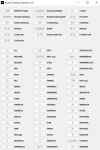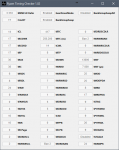curious
Enthusiast
Thread Starter
- Mitglied seit
- 20.02.2003
- Beiträge
- 615
Von den neuen 2nd Generation RYZEN CPUs R5 2600(X) & R7 2700(X) (Pinnacle Ridge) haben sich viele User einen überarbeiteten und potenteren Speichercontroller versprochen, mit dem Speichertaktraten ähnlich denen aus dem Intel Lager möglich sind. Zur Markteinführung scheint sich dieser Wunsch aber zerschlagen zu haben. Der Speichercontroller entspricht weitestgehend dem der Raven Ridge CPUs und bietet zwar eine geringere Speicherlatenz, aber leider keine/kaum höhere Taktraten im Vergleich zu den 1st Gen Summit Ridge Prozessoren (R3/R5/R7 1xxx).
The Stilt fasst die Situation wie folgt zusammen:
Dieser thread soll dazu dienen, die bisher im Forum verstreuten Berichte und Erfahrungen zum Übertakten von RAM mit AMDs neuen 2nd Generation Ryzen Prozessoren R5 2600(X) und R7 2700(X) zu bündeln.
Ryzen RAM Overclocks ©Shaav
Trag bitte auch Deine Ergebnisse ein!
- - - Updated - - -
->
The Stilt fasst die Situation wie folgt zusammen:
The memory controller
The memory controller in Pinnacle Ridge is identical to the one found in Raven. There are some differences in the software configuration, however the Phy IP itself is no doubt identical as the two share the same controller firmwares.
Compared to Summit Ridge, the revised controller in Pinnacle Ridge provides < 8.7% lower access latency on average (2133-3466MHz). The latency difference is largest at =< 2666MHz frequencies and starts to tail off at higher speeds.
Likewise, the SDF latency (Synchronous Data Flow Anm. d. Red.) has slightly benefited from the changes. The average latency improvement (CCX2CCX latency) is < 2.2%, but just like with the memory latency the difference is tailing off as the memory speed increases. At 3200MHz MEMCLK the SDF latency difference almost falls within the margin of error.
https://i.imgur.com/GF3tru1.png
Despite the extremely welcome latency improvement in Pinnacle Ridge, the memory latency is unfortunately still < 38% higher on average (2133-3466MHz) than on its closest rival from Intel (Coffee Lake).
While the changes to the memory controller in Pinnacle Ridge do provide lower latency, unfortunately the highest achievable memory frequency seems to be exactly the same as on Summit and Raven Ridge parts. A realistic expectation would be 3400 - 3533MHz depending on the silicon quality, the motherboard and the DRAM modules used. Some CPU specimens featuring an exceptional memory controller might be able to reach 3600MHz while maintaining true stability, however all of the tested 2700X samples were limited to 3400 - 3533MHz on both Crosshair VII Hero and MSI B350I PRO AC motherboards, regardless of the settings or the memory modules used. The stability was determined using “Ram Test” utility, which obviously sets the bar for stability a lot higher than the tests methods other reviewers typically use to deem the memory as “stable” at certain frequency.
On the tested samples, the distribution of the maximum achievable memory frequency was following:
3400MHz – 12.5% of the samples
3466MHz – 25.0% of the samples
3533MHz – 62.5% of the samples
There are clear differences in how the memory controller behaves on the different CPU specimens. The majority of the CPUs will do 3466MHz or higher at 1.050V SoC voltage, however the difference lies in how the different specimens react to the voltage. Some of the specimens seem scale with the increased SoC voltage, while the others simply refuse to scale at all or in some cases even illustrate negative scaling. All of the tested samples illustrated negative scaling (i.e. more errors or failures to train) when higher than 1.150V SoC was used. In all cases the maximum memory frequency was achieved at =< 1.100V SoC voltage.
AMD has revised the memory layout design guidance with Pinnacle Ridge targeting motherboards (i.e. 400-series) in an effort to potentially make the higher memory frequencies possible.
While this might theoretically improve the frequencies on some motherboards, generally the frequency limiting factor is the memory controller itself and not the topology the motherboard uses for memory signaling. Because of that, the newer 400-series motherboards alone should not be expected to provide improved memory frequencies at least by a significant margin.
Dieser thread soll dazu dienen, die bisher im Forum verstreuten Berichte und Erfahrungen zum Übertakten von RAM mit AMDs neuen 2nd Generation Ryzen Prozessoren R5 2600(X) und R7 2700(X) zu bündeln.
Ryzen RAM Overclocks ©Shaav
Trag bitte auch Deine Ergebnisse ein!
- - - Updated - - -
->
Hi curious,
naja derzeit finde ich es etwas schwierig gute Timings mit den Aktuellen Agesa auf dem C7H lauffähig zu bekommen.
3600 Cl14 15 16 laufen derzeit nicht ganz sauber die Einstellungen weichen zum C6h doch etwas ab.
Morgen baue ich den 2700X mal auf das C6h und schaue wie er mit den anderen Rams läuft
lg
Was ich so gelesen habe (hauptsächlich auf OCN), scheinen die Grundeinstellungen (Terminationswiderstand usw.) durchaus auf das C7H übertragbar zu sein.
Ich hab einen R5 2600 hier, den ich nach zwei frustrierenden Nächten wieder von meinem C6H verbannt habe. Der IMC erlaubt mir zwar problemlos diverse B-die Kits mit 3600 CL14 zu booten und zu benchen (was mit dem R5 1600 nicht möglich war), aber im Stresstest hagelt es nur so Fehler. Selbst mit viel höherer DRAM Voltage bekomme ich meine gewohnten Timings unter 3466 MT/s nicht stabil.
Was die anderen Einstellungen anbelangt (procODT, Rtt, VDDSOC, diverse Spannungen, CAD Bus usw.) ist alles beim Alten geblieben. Da reagiert der IMC 100% genauso wie der des 1st Gen. Ryzen. Wenn es davon Abweichungen gibt, sind die auf das C7H und nicht auf den IMC zurückzuführen.
Der Umstand, dass ich hohe Taktraten und niedrige Timings mit dem R5 2600 booten und benchen kann, legt die Vermutung nahe, dass da tatsächlich auf BIOS/AGESA Seite etwas im Argen liegt und zukünftig noch Einiges rauszuholen ist, aber darauf will ich nicht wetten. Die CPU geht nächste Woche an den Händler zurück.
Bei mir läuft es teils sehr komisch. Manchmal habe ich einen Bootloop, manchmal nicht. Die 3600 CL15 laufen durch memtest (USB boot). Ich habe dasselbe C7H. 3666 dasselbe, jedoch habe ich die noch nicht per memtest getestet, mehr als das bekomme ich nicht mehr gebootet - Wenn ich es bekomme, dann mit sofortigem Bluescreen beim Öffnen eines Programms. Auch scheint die Performance dann zu leiden, denn teils bekomme ich dann weniger score als so, der 2700X macht 500 auf 4,3 GHz im CPU-Z Singlethread.
Ich hoffe selbst darauf dass beim X470 noch was rauszuholen ist. 3800 wären doch lecker. Der Chipsatz ist ja erst am Anfang seiner Reise.
Hm also bei mir sieht das ähnlich aus obwohl ich 3600 CL15 und CL16 fast sauber habe >5 errors im Memtest ist es halt nicht fehlerfrei.
ich kann auch höher booten als 3600 nur sauber bekomme ichs noch nicht....
Zuletzt bearbeitet:







 ist aber nur ein 4500Kit.
ist aber nur ein 4500Kit.

